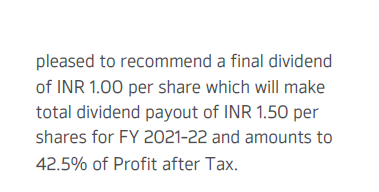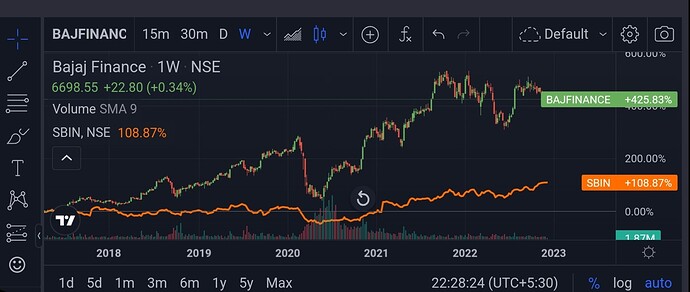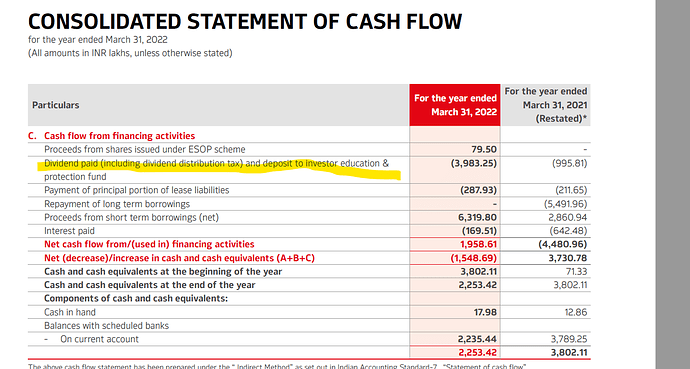I am sure the consistent compounders of the order which you have mentioned grow. Past history tells that. However, when the PSU shares double and Bajaj Finance malingers, you are annoyed. I don’t regret selling either HDFC Bank or Bajaj Finance. I would rather take a risk and buy companies which have not yet caught the market fancy.
You are probably getting misled by recency bias. The comment you have replied to is from 2017. If you take a 5 year view it is very apparent which was a better bet between a Bajaj Fin and SBI, as an example.
If your time horizon is long it is always better to stick with the better business.
Accounting geniuses- I need your help!
I was looking at the FY22 Annual Report of Jamna Auto. They state a dividend payout ratio of 42.5% (screener also shows a similar number). However I am unable to reconcile the same
Below are the snippets from the AR of all the relevant info required for this calculation
EPS Calculation
Dividend paid from consolidated cashflow statement
If we distribute 3983.25 to the weighted avg share holders as per the EPS calculation, the Div per share comes to Rs 1. As a percentage of Profit, it is 28.3%
However the company claims payout of 42.5% as per this

What am I missing here? Shouldn’t the interim dividend of Rs 0.5 payed out be reflected in the consolidated cashflow for the year?
The dividend figure you highlighted consists of an interim dividend of INR 0.5 for the current (FY21-22) year and the final dividend of INR 0.5 for the last (FY20-21) year.
Current (FY21-22) year’s final dividend of INR 1.0 will be paid after approval in the AGM. Before AGM, AR is published and sent to the exchange/shareholders. This amount will reflect in the CF statement of the next (FY22-23) year.
Wow. makes sense now.
Anchored to the text book definition of Div Yield= Payout/net profit, I always thought Div Yield were stated on actuals for the year and should reflect in cashflow.
Thank you for answering my query.
How to evaluate the business in the capacity angle. Let us say company A and B. A make 10 cr and B makes 10 cr.
- A utilizes 50% capacity and B 50%
- A - 100% B - 50%
- A- 50% B - 100 %
Which option is good 2 or 3? and why?
How do you identify the capacity utilization per year? we can easily check the sales per year.
You have to look at the industry, demand, competition and other factors in tandem while studying capacity and utilisation levels.
Go to NSE/BSE website and download the historical bhavcopy for any date in the past… for instance, if you want 12+ years, pick 1 Dec 2010. Then download the current day bhavcopy and compare the two lists (Excel vlookup)… names common in both are the companies that are listed for 12+ years and are still around.
A very very basic question:
Why does a balance sheet has to be balanced? What if assets are more than liabilities or vice versa? Why do they have to nullify each other?
All assets can be funded through either equity or liabilities. So assets and liabilities plus equity must be equal. Else where did that extra asset come from (of top half of balance sheet greater) or where did that extra fund go (if bottom part of balance sheet greater)?
But this is easily found on a simple search on the internet. Is there a deeper query which adds value to this point on the forum?
Do you have to read companies act to understand basic of the law? Does it play any role retail investors like us?
No, knowledge of Companies Act is not required.
There is no simple answer for this. Having spare capacity is good (generally) if the industry is seeing demand growth, or if this particular company is gaining market share, which means the need for production will go up in the future. If the market is not growing, or if this company is losing market share, having spare capacity is waste of resources. Market demand and market share changes can also move quickly, so what’s an asset today may become a problem area tomorrow. Plus need to consider how the additional capacity was built up… is debt used (interest outgo), if not, were there alternate better uses of available capital etc.
Can anyone tell me whether the promoters have taken the loan from the company or is it vice-versa?
DPABHUSHAN_21112022124151_Regulation239.pdf (621.7 KB)
Since company is making the declaration, ‘loan taken’ means company has taken the loan from the promoter. That is how I read it.
Yes, that is what it looks like but since it is usually other way around so was wondering if this is true… thank you.
The long term fundamentals based approach says that we should not try to time the market.
Lets examine this approach. Whosoever invested in say May to August 2020 reaped the benefits. This approach does sit well with the long term, fundamentals based approach. We are told Warren Buffet was willing to wait interminably for a stock to reach the level at which he would feel that the price was reasonable.
But here is the nub. If you stock has sunk, and upto that time you were fully invested, from where do you get the money for the purchase at the time of market fall?
So, this implies having liquidated some part of the portfolio, say in March 2020.
The question becomes important in view of the present day market volatility. I am invested in it upto my neck. So, do I sell some shares so that I have money in case the market really takes a dive?
Howsoever I try to look the other way, fact is most of my stocks are at lower than the purchase price.
I am not asking for a forecast. I also don’t believe in that sort of thing. But what should be the strategy if you feel that the market is going to take a tumble?
Add to this, coincidentally I am reading Dorsey’s Five Rules these days. While I was reviewing my transactions for 2022, I realised that my brokerage and taxes etc were more than the profits I may have made this year. Let me hasten to end that most I sell only the tanking shares, so mostly my actual profit is rather low.
That however, does not take anything away from the fact that it is silly to pay so much brokerage. So, buying selling, the itch for a churn in the portfolio has to be curbed.
@meekinvestor
May be you should invest major.part of your overall investible funds into mutual funds where buying and selling will not be your job. Fund manager will take those decisions. You just invest and forget about it. May be maximum 10% to 25% you can put into direct stocks where you have to take hard decisions.
This is similar to Job and Business.
If you are of the type for whom your boss has to take decision and you are happy with monthly guaranteed salary, no tension of marketing, selling, manufactring, risks financial troubles then Job is best for you.
But if tou have an itch to do all things yourself, take.on all tensions and headaches…then get into it directly.
Hi Mudit, the dilemma is because I want to do it myself. I have, in the past, created some wealth. My problem I have identified is of identifying a stock after a goodish research and then losing confidence in it.
This is specially true of unfamiliar companies.
My question though is not only about myself, but in general-should you sell if you feel the bear approaching?
My thoughts based on whatver experience i have in markets would be
SELL if the business does not hold promise or you find another lucrative opportunity better than the one holding right now or if you know you can get entry again at lower prices
General bearishness in market can not and should not be the reason
Many such drawdowns happens over investing journey
2020 drawdown --those who sold, could not buy back as prices ran away faster and they have to buy again at higher prices
So when selling, one is making two decisions
one to sell at correct prices
second to buy again at correct prices
now getting it correct both times for same stock and then repeating it multiple times in journey is really challenging
Ofcourse some people claim to do that --but that percentage, I assume is very less and we dont know how much it it true
I would say traders do it more and investors do it less
So best part here is to identify ourselves --in which domain we lie



